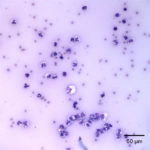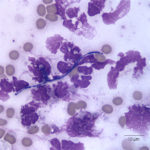Synovial Fluid from a Foal
Case Information
A 3-week-old thoroughbred filly was presented to the Cornell University Hospital for Animals (CUHA) for acute left hind limb lameness and fever. Two days prior to presentation to CUHA, the filly was found acutely lame with a suspicion of trauma (stepped on by another horse).
On presentation, the filly weighed 88 lb and had a temperature of 102.9ºF. The foal was quiet, alert and responsive, but was non-weight bearing on the left pelvic limb and had a moderately sized warm swelling over the left hip with no signs of external trauma. The rest of the physical examination was within normal limits. Blood was drawn for a complete blood count (CBC), equine IgG and serum amyloid A (SAA) testing.
The CBC revealed a microcytic normochromic anemia (27% Hct, 34-46%) with a leukocytosis of 15.8 x 103/uL (reference interval, 5.2 – 10.1 x 103/uL) consisting of a mature neutrophilia of 13.1 x 103/uL (reference interval, 2.7 – 6.6 x 103/uL). The SAA concentration was higher than the upper detection limit of 2500 ug/mL and the fibrinogen concentration by heat precipitation was 700 mg/dL (reference interval, 100-200 mg/dL). The serum IgG was 671 mg/dL (reference interval in adults, 984 – 1685 mg/dL).
Radiographic examination of the left pelvic limb and an abdominal ultrasonographic examination revealed no abnormalities. An ultrasound-guided fine needle aspirate was performed on the swelling and submitted to Clinical Pathology for a joint fluid analysis. The fluid was medium red, opaque and had decreased viscosity. The nucleated cell count was 51.5 x 103/uL, the RBC count was 441.2 x 103/uL, and the total protein (refractometer) was 5.7 g/dL.
Examine the representative images of the joint fluid that are provided below and answer the following questions:
- How would you classify this joint fluid?
- Based on the cytological findings and the history of this foal, what are your differential diagnoses?
- What other diagnostic test should be performed?
 |
 |
Answers on next page
